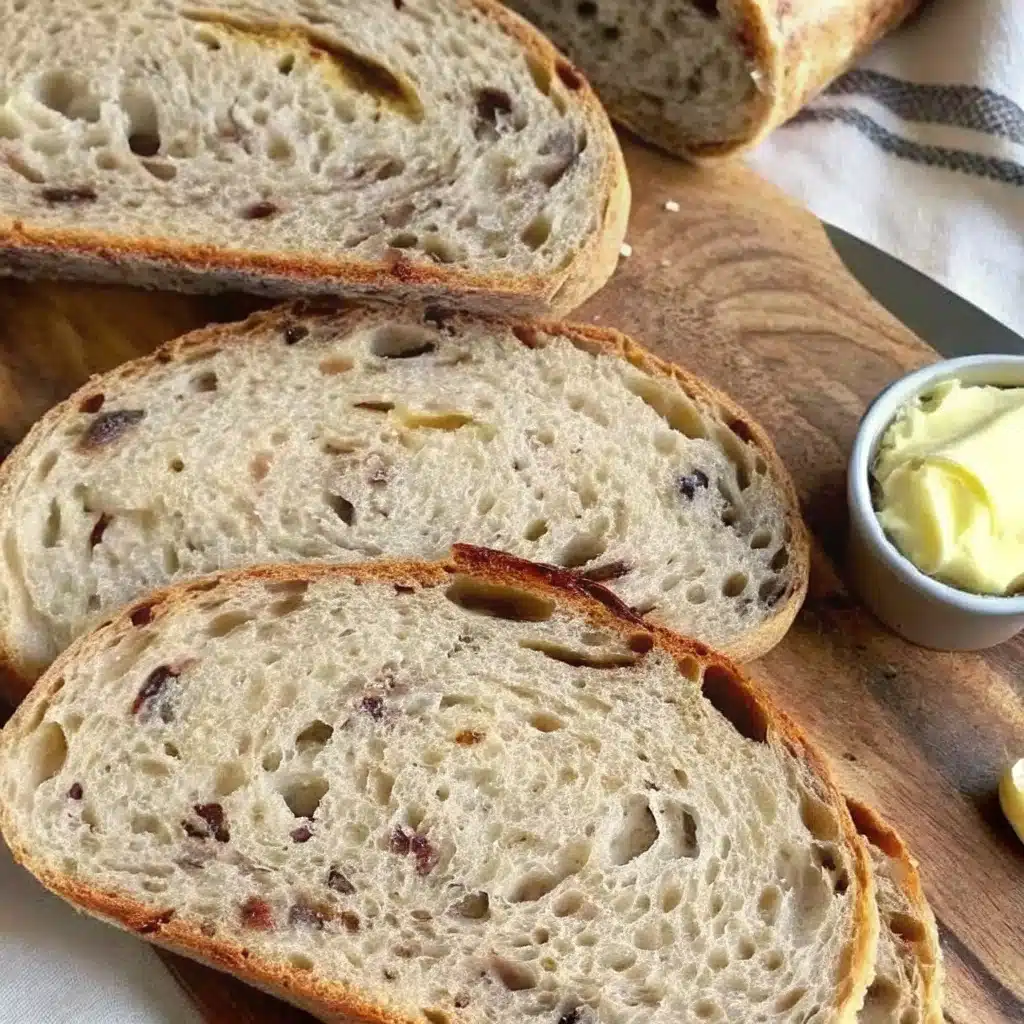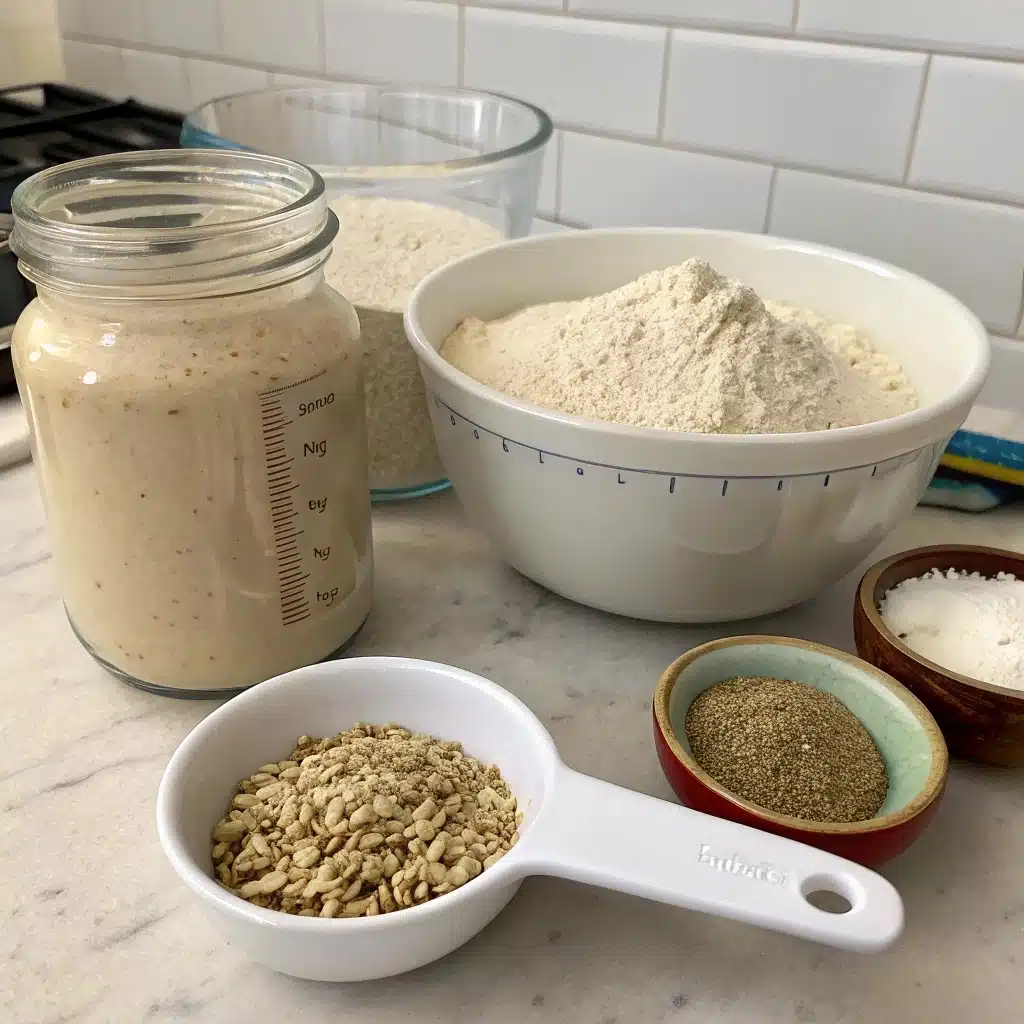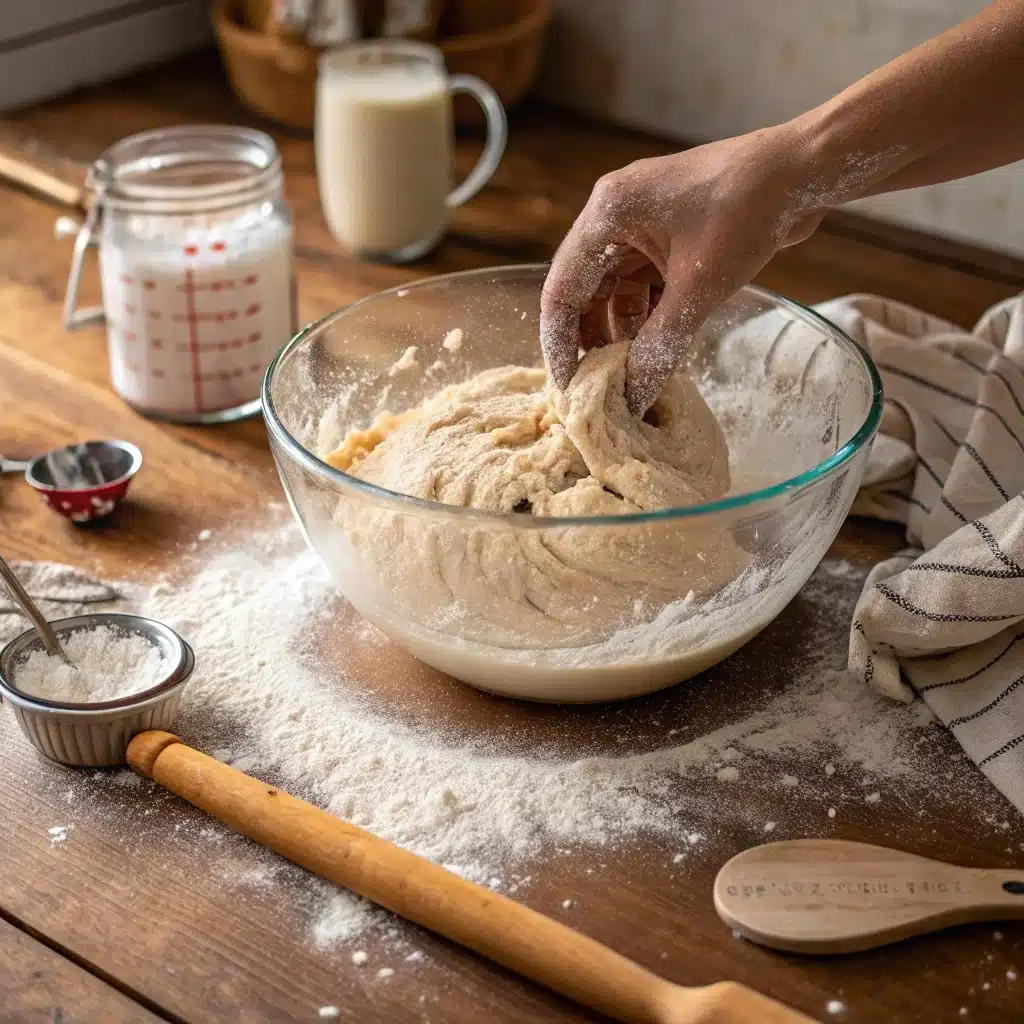When it comes to boosting your nutrition, protein sourdough bread is a delicious game-changer. It combines the tangy charm of traditional sourdough with the fuel your body craves—protein. Whether you’re training hard, managing your blood sugar, or feeding your family smarter, this loaf delivers. In this guide, you’ll discover why protein sourdough bread stands out from the rest, how to bake it at home, and which ingredients transform it into a nutrient-dense powerhouse. We’ll start with a personal story, explore its benefits, and answer your top questions so you can enjoy each slice with confidence and flavor.
Table of Contents

The Story & Intro
Baking Smarter with Protein Sourdough Bread
Hi, I’m Lisa Hartwell—a 53-year-old home cook from sunny Santa Barbara, California. I didn’t set out to create protein sourdough bread. It happened out of sheer necessity. As a single mom raising twin boys, I was always battling picky appetites. They’d scoff at anything green, but bread? That was my opening. I started baking sourdough from scratch—more out of desperation than craft. But then I wondered: what if I could sneak in some protein without changing the taste?
So I stirred whey protein into the dough. The boys didn’t just eat it—they devoured it. That was the spark. From then on, protein sourdough bread became a regular thing in our kitchen. I played with ingredients like vital wheat gluten and sunflower seeds, adjusting ratios, testing textures. Before I knew it, I wasn’t just baking—I was building nutrition into every slice.
As I got older, I realized how vital protein is for me, too—not just my kids. Especially for women in our 40s and beyond, keeping muscle strong means everything. Pairing sourdough’s slow fermentation with protein-rich ingredients turned everyday bread into a gut-friendly, energy-sustaining win.
It’s why protein sourdough bread is now my favorite go-to. It powers up avocado toast, makes the perfect sandwich base, and supports my health in every bite. If you’re looking for a nourishing, practical way to upgrade your meals, this is it. And if you’re craving variety, check out our keto sourdough bread and organic sourdough bread—both offer creative twists that fit beautifully into a wellness-focused kitchen.
Let’s dig deeper into what makes this bread such a standout.
What Makes Protein Sourdough Bread Special
Why Protein Elevates Classic Sourdough
Traditional sourdough has always had its place at the table—rustic, tangy, and gut-friendly. But when you add protein into the mix, the benefits multiply. Protein sourdough bread isn’t just a trend—it’s a smart solution for everyday nutrition. Instead of relying solely on carbs, you’re feeding your body with the building blocks it needs to maintain energy, support metabolism, and fuel recovery.
By enhancing sourdough with protein, you’re not sacrificing taste or texture. In fact, you’ll likely notice a heartier bite and longer-lasting satisfaction. It’s ideal for anyone balancing blood sugar, managing weight, or just seeking a more functional food. For athletes, active adults, or growing teens, it’s a fantastic way to support muscle without compromising flavor. Plus, the slow fermentation of sourdough helps make protein easier to digest and absorb—an underrated benefit of this pairing.
You can enjoy it plain or with your favorite toppings. Personally, I love mine toasted with almond butter or turned into a loaded veggie sandwich. It’s also amazing with a slice of turkey and a crisp apple on the side. If you’re craving variety, the low calorie sourdough bread version is a great option for lighter meals, and the sourdough French bread makes a delicious twist when you want a little elegance.
Gut-Friendly Meets Muscle-Friendly
One of the biggest reasons protein sourdough bread stands out is how it supports both gut health and muscle repair in one package. Sourdough’s natural fermentation breaks down gluten and phytic acid, making it gentler on digestion. When paired with protein—like whey, hemp, or even quinoa flour—it helps nourish without bloating or heaviness.
This bread fits beautifully into almost any dietary lifestyle. Whether you’re focused on clean eating, intuitive meals, or fueling for workouts, protein sourdough bread checks every box. It’s smart, satisfying, and surprisingly easy to make from home.
Let’s explore which ingredients deliver the most impact in the next section.
Key Ingredients That Maximize Protein
Smart Add-ins for Powerful Protein Sourdough Bread
To turn a traditional loaf into protein sourdough bread, the secret lies in smart, strategic ingredients. We’re not talking about tossing in random protein powder and hoping for the best. Each component plays a role in texture, flavor, and digestibility. One of the most reliable additions is vital wheat gluten—a concentrated protein derived from wheat. It strengthens the dough and gives it that classic chewy structure, all while boosting the protein content significantly.
Whey protein isolate is another favorite in my kitchen. It blends smoothly into wet doughs and brings a creamy finish without overpowering the sourdough tang. You can also experiment with plant-based proteins like pea, hemp, or soy. These options add earthier flavors and can be combined with seeds like chia, flax, or sunflower for texture and omega-3 benefits.

Don’t overlook flours like chickpea, quinoa, and spelt, which naturally contain more protein than standard white flour. Blending these with bread flour or whole wheat gives a solid nutritional profile while maintaining structure.
The real magic happens when these ingredients meet sourdough’s natural fermentation. The starter helps break down anti-nutrients that typically block protein absorption, making protein sourdough bread not just high in protein—but bioavailable and nourishing.
Fermentation + Protein = Digestive Harmony
One of the most unique features of protein sourdough bread is how well it digests. Thanks to lactic acid bacteria in the sourdough starter, the fermentation process pre-digests much of the gluten and phytic acid. This means your body can better absorb nutrients like iron, magnesium—and yes, protein.
This synergy makes the bread feel light on your stomach but still satisfying. It’s especially helpful for people with mild gluten sensitivity or digestive concerns. I’ve even found it more filling than regular high-protein breads because of its balanced macro profile.
If you want to pair it with something energizing, try this protein coffee recipe in the morning, or build a lunch around calories in sourdough bread to keep portions mindful yet hearty.
For more fun variations and ideas, check out our Facebook and Pinterset sections where creativity meets craving.

Protein Sourdough Bread
Ingredients
Equipment
Method
- In a large bowl, mix flour, vital wheat gluten or chickpea flour, and salt. Add sourdough starter, water, and protein powder.
- Stir or knead gently until dough forms. Let it rest for 30 minutes.
- Perform stretch-and-folds every 30 minutes for 2 hours to develop gluten structure.
- Cover and bulk ferment at room temperature for 6–8 hours until dough has doubled in size.
- Shape into a round or oval loaf. Place in proofing basket and let rise for another 1–2 hours.
- Preheat oven to 475°F (245°C). Bake in a Dutch oven for 20 minutes covered, then 20 minutes uncovered.
- Let bread cool completely on a rack before slicing. Store in linen or freeze slices for later.
Nutrition
Notes
Tried this recipe?
Let us know how it was!How to Bake High-Protein Sourdough at Home
Simple Steps to Make Protein Sourdough Bread
Baking protein sourdough bread at home isn’t as intimidating as it sounds. In fact, once you’ve got your sourdough starter thriving and a few high-protein ingredients on hand, the rest falls into place. Start with a base of strong bread flour or whole wheat, then add 10–15% of your flour weight in vital wheat gluten or chickpea flour. This ensures your dough stays elastic and structured while boosting its protein level.
Mix your dough with your sourdough starter, water, salt, and protein additions (like whey isolate or hemp flour). I find it helpful to mix by hand first, then use stretch-and-fold techniques every 30 minutes over 2 hours to develop gluten naturally.
After bulk fermentation—usually 6–8 hours—shape your loaf and let it rise in a proofing basket or bowl. For the final bake, I use a Dutch oven at 475°F for 20 minutes covered, then 20 minutes uncovered. You’ll get a golden crust and a soft, chewy crumb that feels both indulgent and energizing.

Store your protein sourdough bread wrapped in linen at room temperature for up to 3 days—or slice and freeze for longer storage. You can toast slices directly from frozen for easy breakfasts or post-workout snacks.
Want inspiration for flavor variations? Try this blueberry sourdough bread for a fruity protein twist, or browse gluten-free whole grain bread options if you need something lighter.
Baking for Flavor, Fuel & Simplicity
The beauty of baking protein sourdough bread at home is that you’re in control. You can balance flavor with nutrition, tailor ingredients to your needs, and skip additives found in store-bought breads. And let’s be honest—few things beat the smell of fresh bread baking in your kitchen.
As someone who once dreaded meal prep, I now look forward to baking day. It’s comforting, grounding, and gives me food I actually feel good eating. Whether you’re prepping for your family or meal-planning for workouts, a fresh loaf of protein-rich sourdough is pure gold.
Before we wrap up, let’s answer the top questions people have about protein sourdough bread.
FAQs About Protein Sourdough Bread
Is sourdough bread high in protein?
Standard sourdough bread has a modest protein content, typically around 3–5 grams per slice depending on the flour used. But when you make protein sourdough bread, that number can double or even triple. By adding ingredients like vital wheat gluten, whey isolate, or chickpea flour, you’re turning a traditional loaf into a true protein-packed option.
How much protein is in a slice of sourdough bread?
In typical bakery sourdough, a slice contains about 4 grams of protein. But in a well-crafted protein sourdough bread, you can expect anywhere from 8 to 12 grams per slice—depending on the flour blend and added protein sources. If you portion your loaf evenly, it’s easy to track macros while still enjoying real, whole food.
What bread has the most protein?
Among all types, protein sourdough bread ranks high due to its customizable nature. While commercial high-protein loaves may advertise impressive numbers, they often include additives or preservatives. A homemade version using natural fermentation and quality protein sources like hemp, flax, or vital wheat gluten can match or exceed store-bought levels—and taste better, too.
Why do bodybuilders eat sourdough bread?
Bodybuilders value protein sourdough bread for its balanced carbs, digestibility, and protein potential. The slow fermentation process supports gut health, and when paired with added protein, it becomes an ideal post-workout or muscle-maintenance food. Plus, it avoids the bloating some people feel with traditional white bread—making it a cleaner, more functional carb source.
Conclusion: Why Protein Sourdough Bread Deserves a Spot in Your Routine
In a world of ultra-processed snacks and short-lived diet trends, protein sourdough bread stands out as a wholesome, flavorful staple. It offers the deep, tangy taste of traditional sourdough while delivering a protein boost your body truly benefits from. Whether you’re powering through workouts, managing your macros, or feeding a family, this bread fits beautifully into any routine.
Homemade versions give you full control over ingredients, texture, and nutrition. Add a personal twist, bake in batches, and freeze for the week ahead. Once you’ve had your first warm slice, packed with flavor and fuel—you’ll never go back.
